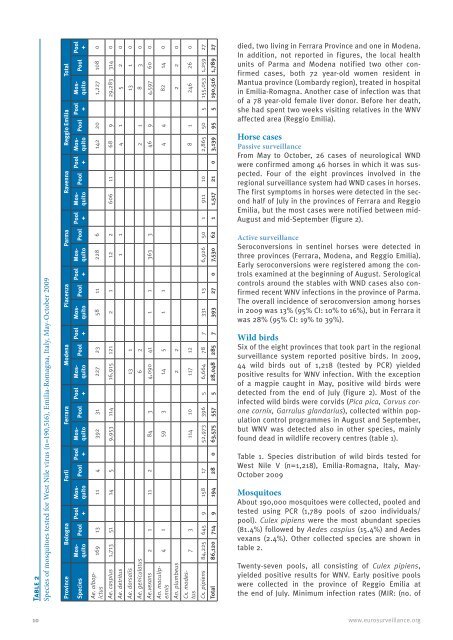Vector-borne diseases - Eurosurveillance
Vector-borne diseases - Eurosurveillance
Vector-borne diseases - Eurosurveillance
You also want an ePaper? Increase the reach of your titles
YUMPU automatically turns print PDFs into web optimized ePapers that Google loves.
Table 2<br />
Species of mosquitoes tested for West Nile virus (n=190,516), Emilia-Romagna, Italy, May-October 2009<br />
Province Bologna Forlì Ferrara Modena Piacenza Parma Ravenna Reggio Emilia Total<br />
Mos-<br />
Species<br />
Pool<br />
quito<br />
Pool Mos-<br />
Pool<br />
+ quito<br />
Pool Mos-<br />
Pool<br />
+ quito<br />
Pool Mos-<br />
Pool<br />
+ quito<br />
Pool Mos-<br />
Pool<br />
+ quito<br />
Pool Mos-<br />
Pool<br />
+ quito<br />
Pool Mos-<br />
Pool<br />
+ quito<br />
Pool Mos- Pool Mos-<br />
Pool Pool<br />
+ quito + quito<br />
Pool<br />
+<br />
Ae. albop-<br />
169 13 11 4 392 31 227 23 58 11 228 6 142 20 1,227 108 0<br />
ictus<br />
Ae. caspius 1,713 51 14 5 9,953 114 16,915 121 2 1 12 2 606 11 68 9 29,283 314 0<br />
Ae. detritus 1 1 4 1 5 2 0<br />
Ae. dorsalis 13 1 13 1 0<br />
Ae. geniculatus 6 2 2 1 8 3 0<br />
Ae.vexans 2 1 11 2 84 3 4,090 41 1 1 363 3 46 9 4,597 60 0<br />
An. maculip-<br />
4 1 59 3 14 5 1 1 4 4 82 14 0<br />
ennis<br />
An. plumbeus 2 2 2 2 0<br />
Cx. modes-<br />
7 3 114 10 117 12 8 1 246 26 0<br />
tus<br />
Cx. pipiens 84,225 645 9 158 17 52,973 396 5 6,664 78 7 331 13 6,926 50 1 911 10 2,865 50 5 155,053 1,259 27<br />
Total 86,120 714 9 194 28 0 63,575 557 5 28,048 285 7 393 27 0 7,530 62 1 1,517 21 0 3,139 95 5 190,516 1,789 27<br />
died, two living in Ferrara Province and one in Modena.<br />
In addition, not reported in figures, the local health<br />
units of Parma and Modena notified two other confirmed<br />
cases, both 72 year-old women resident in<br />
Mantua province (Lombardy region), treated in hospital<br />
in Emilia-Romagna. Another case of infection was that<br />
of a 78 year-old female liver donor. Before her death,<br />
she had spent two weeks visiting relatives in the WNV<br />
affected area (Reggio Emilia).<br />
Horse cases<br />
Passive surveillance<br />
From May to October, 26 cases of neurological WND<br />
were confirmed among 46 horses in which it was suspected.<br />
Four of the eight provinces involved in the<br />
regional surveillance system had WND cases in horses.<br />
The first symptoms in horses were detected in the second<br />
half of July in the provinces of Ferrara and Reggio<br />
Emilia, but the most cases were notified between mid-<br />
August and mid-September (figure 2).<br />
Active surveillance<br />
Seroconversions in sentinel horses were detected in<br />
three provinces (Ferrara, Modena, and Reggio Emilia).<br />
Early seroconversions were registered among the controls<br />
examined at the beginning of August. Serological<br />
controls around the stables with WND cases also confirmed<br />
recent WNV infections in the province of Parma.<br />
The overall incidence of seroconversion among horses<br />
in 2009 was 13% (95% CI: 10% to 16%), but in Ferrara it<br />
was 28% (95% CI: 19% to 39%).<br />
Wild birds<br />
Six of the eight provinces that took part in the regional<br />
surveillance system reported positive birds. In 2009,<br />
44 wild birds out of 1,218 (tested by PCR) yielded<br />
positive results for WNV infection. With the exception<br />
of a magpie caught in May, positive wild birds were<br />
detected from the end of July (figure 2). Most of the<br />
infected wild birds were corvids (Pica pica, Corvus corone<br />
cornix, Garrulus glandarius), collected within population<br />
control programmes in August and September,<br />
but WNV was detected also in other species, mainly<br />
found dead in wildlife recovery centres (table 1).<br />
Table 1. Species distribution of wild birds tested for<br />
West Nile V (n=1,218), Emilia-Romagna, Italy, May-<br />
October 2009<br />
Mosquitoes<br />
About 190,000 mosquitoes were collected, pooled and<br />
tested using PCR (1,789 pools of ≤200 individuals/<br />
pool). Culex pipiens were the most abundant species<br />
(81.4%) followed by Aedes caspius (15.4%) and Aedes<br />
vexans (2.4%). Other collected species are shown in<br />
table 2.<br />
Twenty-seven pools, all consisting of Culex pipiens,<br />
yielded positive results for WNV. Early positive pools<br />
were collected in the province of Reggio Emilia at<br />
the end of July. Minimum infection rates (MIR: (no. of<br />
10 www.eurosurveillance.org

















